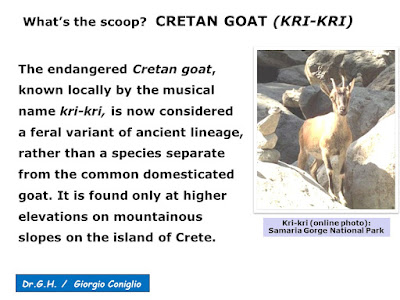CURRENT CONTENTS:
Angwantibo
Bats
Beaver
Buffalo
California sea lion
Coyotes (plastic)
Cretan goat (kri-kri)
Gnus (upsetting)
(for continuation, see the link below)
Authors' Note: The angwantibo (an-GWAN-tee-boh) or golden potto, Calabar angwantibo, is a small golden-haired primate inhabiting parts of Central Africa, including the country of Gabon. It undertakes its propagation rituals while hanging from the branches of trees. The results of attempts at such matings by unskilled participants are unrecorded.
To some readers the name Geebo may seem unlikely, but the author assures you that for the first twenty years of his life this nickname (one of the few of which he approved) was in common use, at least by his siblings; it is still used occasionally in close circles.
Authors' Note: BATS, the flying mammals, are found in many idioms, which mostly give them unfavorable press, including:
batty,
old bat,
to have bats in the belfry,
(take off) like a bat out of hell,
as blind as a bat.
Authors' Note: The California sea lion, Zalophus californianus, native of the west coast of North America, has increased in population considerably in recent years. The marine mammal is sexually dimorphic, with males larger in size and having more commanding vocal abilities than the females. Both genders are larger and more socially active than the true 'earless' seals, which can move on land only by scooting on their bellies.
Sea lions are highly intelligent, and positioning their front flippers, they can support themselves in a 'four-legged' walk; their ability to learn and perform tricks has given them a role as the (misnamed) 'circus seal'.
 |
Follow-up note: As is often the case, e.g. with bears or raccoons, feeding wild animals can result in untoward behaviour. On our subsequent two-week visit to California in early April 2022, we saw no such disreputable behavior by sea lions (but it must be admitted that we saw no sea lions, although we certainly heard them barking, particularly around the piers at Monterey).
Authors' Note: Two major species of gnu (genus Connochaetes) are found in Africa — the black wildebeest (C. gnou) and the blue wildebeest (C. taurinus). The blue species is somewhat larger, and their horns are of different configuration; other differences are minor. The two species overlap in their range, but there is no other recorded instance of animosity or prejudice deriving from these differentiating traits.
Requests from many armchair naturalists, and career zoologic scientists have come to fruition; there is now a followup post continuing this theme that you can easily access by clicking HERE!












No comments:
Post a Comment